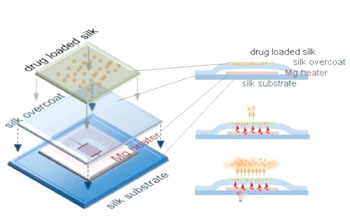Wireless Therapy Device Facilitates Drug Delivery
By HospiMedica International staff writers
Posted on 08 Jan 2015
A novel electronic implant triggered remotely by a wireless signal delivers heat to infected tissue, enhancing antibiotic release without reducing antibiotic activity.Posted on 08 Jan 2015
Developed by researchers at Tufts University (Medford, MA, USA), the implantable therapeutic device was designed to counter Staphylococcus aureus infections. The fully degradable, remotely controlled, therapeutic device can be left behind at a surgical or suturing site for infection management by either thermal treatment and/or by remote triggering of drug release when there is retardation of antibiotic diffusion, in deep infections, or when systemic antibiotic treatment alone is insufficient due to the emergence of antibiotic-resistant strains.

Image: Schematic model the dissolving silk and magnesium electronic implant (Photo courtesy of Tufts University).
The device includes a serpentine resistor and a power-receiving heater coil made of magnesium that is inserted into a silk protein "pocket" that protected the electronics and controls the dissolution time. The packaging and electronics are turned on remotely after implantation, providing the necessary thermal therapy or to trigger drug delivery; after completion of function, the device is safely resorbed into the body, within a programmable period, obviating the need for secondary surgeries and retrieval. A study describing the device was published in the December 2014 issue of the Proceedings of the National Academy of Sciences of the United States of America (PNAS).
“This is an important demonstration step forward for the development of on-demand medical devices that can be turned on remotely to perform a therapeutic function in a patient and then safely disappear after their use, requiring no retrieval,” said senior author Professor of Biomedical Engineering Fiorenzo Omenetto, PhD. “These wireless strategies could help manage postsurgical infection, for example, or pave the way for eventual 'wi-fi' drug delivery.”
Implantable medical devices typically use non-degradable materials that have limited operational lifetimes and must eventually be removed or replaced.
Related Links:
Tufts University














